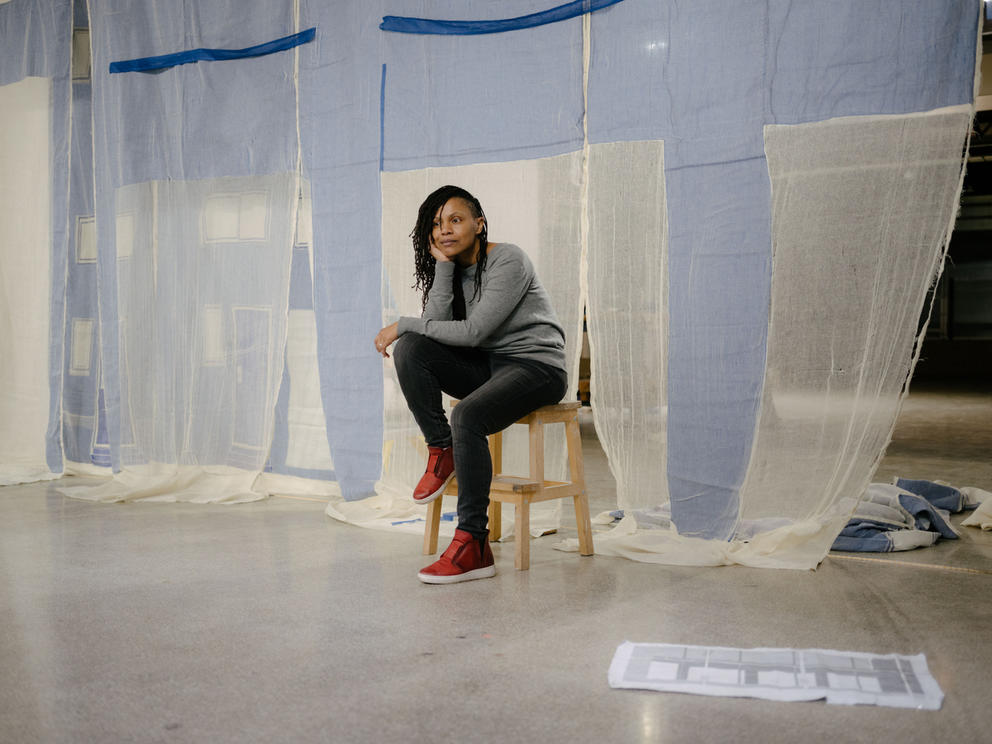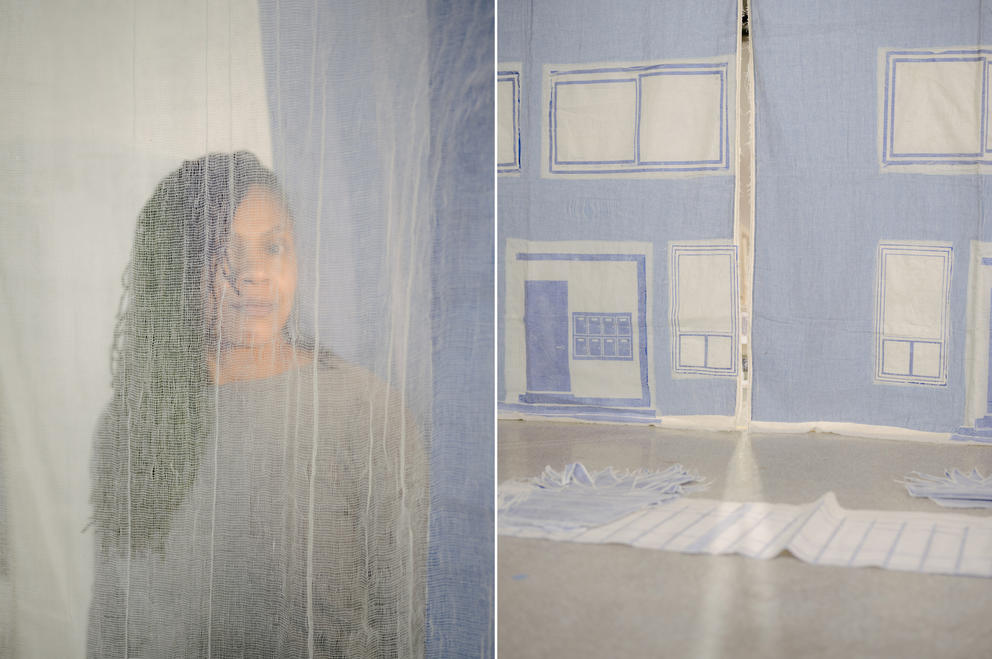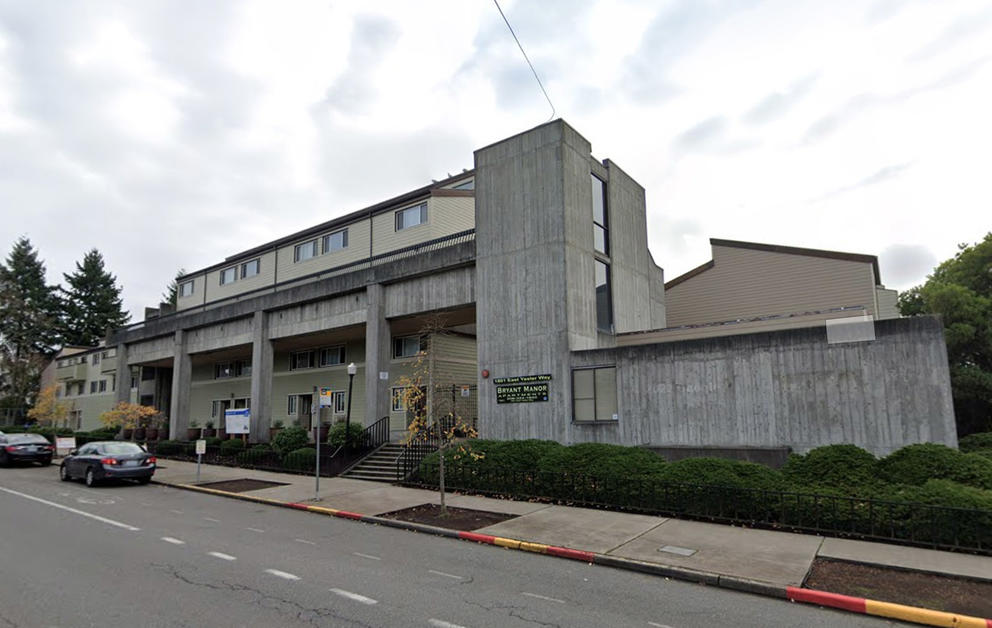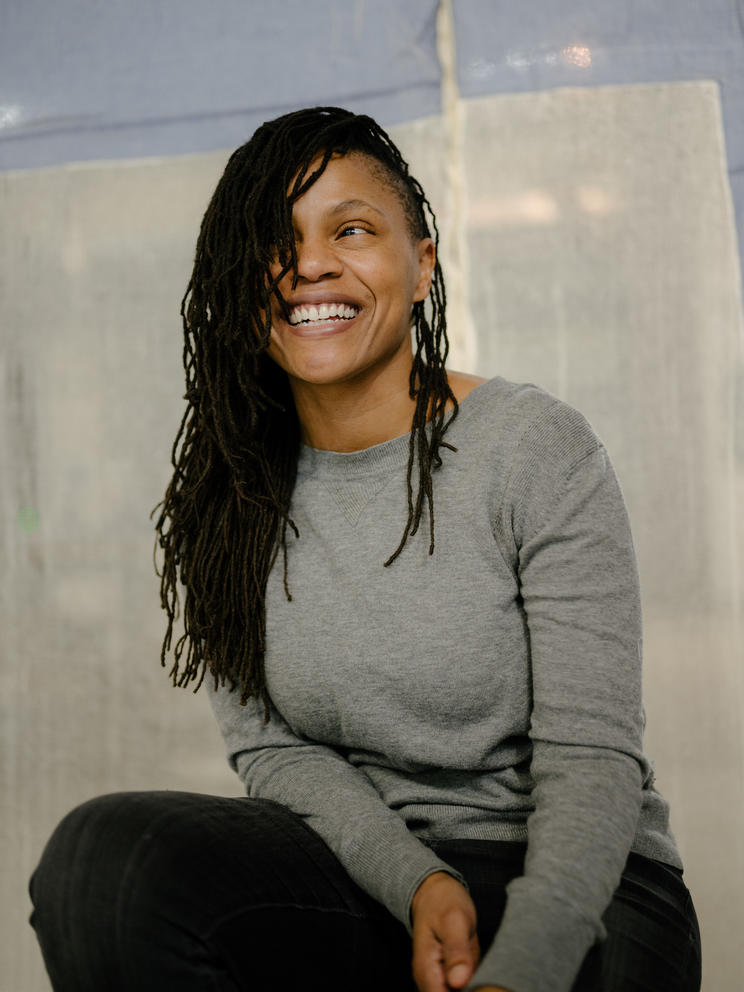“I remember having a sense of grief,” Agbro says. She knew it meant that soon her memories of Bryant Manor would be all that remained. “Just another place in Seattle that was: ‘We're gonna tear it down.’ ”
Now, almost two years later, Agbro is re-creating her childhood home in South Lake Union’s MadArt Studio as part of her immersive exhibition, P.L.U.A. (Proposed Land Use Action). Visually and thematically, the show takes from those tall, graphic, blue-and-white harbingers of change that have mushroomed across Seattle, particularly in the historically Black, now gentrified Central District.
“There’s so many buildings that have disappeared in the city over the last 10 years,” says Agbro, who now lives in Wallingford. “I thought that this would be a way to pour that grief into something that was constructive.”
Agbro started the “construction” of her immersive exhibit at the South Lake Union art space in late January. The show officially opens Sunday, March 13, but visitors can stop by before then to see the artist working on the installation, which will consist of 12-foot-tall “walls” made of layers of fabric. Collaged and printed to represent the Bryant Manor exterior in a pared-down, graphic style drenched in the saddest shades of blue, the textile screens will hang from the gallery’s auto-row-era steel beams.
Together, these billowing walls will form a sort of hallway that visitors can move through, like the wings of a theater stage. “I don’t want the piece to be hard,” Agbro told me during a recent visit to the space. “It’s a soft experience.”
Jite Agbro’s immersive exhibit consists of 12-foot “walls” of fabric. The blue and white design represents the exterior of Bryant Manor. It will officially open at MadArt on March 13, but visitors can stop by the tall-windowed space to see her building the installation. (Grant Hindsley for Crosscut)
It’s only the first week of Agbro’s tenure, and already about a dozen panels — spanning the 48-foot width of the Westlake Avenue-facing space — waterfall down to the floor. These form the outermost elements of Bryant Manor’s facade, the concrete brutalist beams that surround the interior structure like an exoskeleton.
Navy-blue doors and windows appear through see-through sections in the outermost scrim. It feels as if a petite cartoon human could step out at any moment to open one of the tiny square mailboxes. In front, currently still on the floor, rests a denim-blue fabric fence and oversized flower pots. The ladder Agbro is using to execute the installation — firefighter red with yellow feet — clashes with the peaceful shades of washed indigo.
Though the fabrics look like blue prints, they’re not blueprints, Agbro notes. She’s not rebuilding the late-’60s Yesler Way structure in any precise way. What she’s constructing is somewhere in between a real place and a memory palace — an imaginary location to store the things she doesn’t want to forget.
“I felt like a from-memory, slightly wistful, cartoonish thing made sense because that’s how I remember it,” Agbro, now 39, says. “It seemed appropriate because all I have from that place is memories. I haven't lived there in more than 20 years.”
Like a veil of time, the details — the windows, doors, planters — will be covered with a layer of “grade 10” cheesecloth, which is woven so loosely the fabric is gauzelike, mostly transparent. Its slight crêpe texture gives the installation an ethereal quality, like a faded vintage photo.
“I like that they're kind of wispy, a little fragile, but they have structure,” Agbro says of her choice of fabrics. What she likes the most is that the seams are visible and that the edges remain rough, fraying as if they’ve been washed one too many times. “I like the approachability of humble materials,” she says. “From a distance, these layers of different kinds of fabric kind of look like denim. That’s on purpose because we all are very familiar with denim…. If the thing looks too expensive, or it looks too delicate, you don’t really feel like you belong there.”
Textiles have always held sway over Agbro, who once wanted to become a clothing designer or maker (a visit to the Tommy Hilfiger headquarters in New York changed her mind). To this day, Agbro often incorporates cloth and “soft” textures like kozo (Japanese paper made from mulberry trees) or banana paper into her paintings and sculptures.
While her earlier paintings often popped with oranges and reds, her larger-scale work has been steeped in blue the past few years. In a prepandemic large-scale installation at the Bainbridge Art Museum, large abstracted figures, like human shadows, peeked through the windows of her quiltlike, collaged fabrics, which floated from the museum’s second floor down through an open gallery to the first.
In spring 2020, Agbro installed a series of collaged blue-and-white fabric and paper panels at the new Central District PCC supermarket, housed in the base of one of several new modern apartment buildings on the corner of 23rd and Union. Each panel depicts an abstracted architectural image of Central District institutions like the Langston Hughes Performing Arts Institute or Fats Chicken and Waffles.
“I always end up making these blue pieces when something’s large and maybe a little melancholy,” Agbro says. “I guess it’s kind of cliché. It’s blue because the subject is kind of blue.”
The installation at MadArt is her most sprawling work to date. Agbro tilts her head slightly and walks through an A-shaped opening in the panels. At this early point in her two-month installation process, it’s not yet a portal into Bryant Manor 2.0. But it offers a glimpse into the “backstage” machinations of a major art project. A large square table holds a laptop, sewing machine, iron and gently draped strips of blue cotton voile, which Agbro will later attach to the larger pieces of fabric already hanging. Piles of folded-up sheets dot the floor. “Everything on the floor here is a wall,” she explains. “They’re almost done.”
The work that remains is mostly in the details: sewing on strips of indigo cotton voile — “the shadows,” as Agbro puts it — as well as adding images of mailboxes, windows and maple trees. The details, screen-printed on kozo, will make the walls come alive.
“I could go so far as to print little mice running around the flowers, or little bushels of grass,” Agbro says. “The chain-link fences where I used to see tennis shoes hanging … those are the things that will make the piece more poignant. That’s part of the reason I wanted to do the construction of the panels beforehand, because I really wanted to spend my time here creating a place with those details, those memories.”
Agbro lived in the building with her mother and three siblings for more than a decade, from the age of 2 through 15. Growing up in Bryant Manor put her squarely at the heart of the mix of cultures that make the neighborhood — and Seattle — great, Agbro says: A Buddhist temple, the Chinatown-International District, Douglass Truth Library, Garfield High School, and Pratt Fine Arts Center were all within walking distance.
“After seeing the [land use notice] sign, I really started to think about the value of growing up in the middle of a pretty vibrant city,” Agbro says. “My family didn't have a lot of money, but the kids in my family ended up with lots of cultural capital because of where we lived.”
It was Agbro’s proximity to Pratt that kicked off her love for art. At 9 years old, Agbro wandered in to the school, and attended a free Saturday class after a teacher invited her into the classroom. She kept taking classes for years. “To some extent, [that’s] the only reason I’m sitting here today,” she says.
Bryant Manor was constructed in the late 1960s and early 1970s, roughly two decades before Agbro was born. The building, which is still standing, houses 58 units of low-income apartments. The new complex — which will be built in phases to limit displacement of the current residents — will be able to house many more people, with a total of 242 one-, two-, three- and four-bedroom units, though only 58 of those will be reserved for low-income families (the rest are affordable units). But it is unclear when construction will start.
On a recent weekday, the sign announcing “2 new apartment buildings” was still posted in the mulch. The image is one of the last fabric details Agbro has yet to print. “I wanted it to be part of this show, specifically, because the shapes and the way the typography is structured in those signs immediately tell you what it is. There's so many of them around the city that your eye becomes familiar with it from far away, before [you] even read the details.” (Though it should be noted: the city gave the signs a facelift in 2017; now, instead of “Proposed Land Used Action,” they say “Seattle Department of Construction and Inspections is reviewing.”)
What is often missing from these public notices is a sense of human presence. “There’s something cold about those signs,” Agbro says. “We’re just plowing right along. There’s literally people walking out of this building with their kids!”
It’s in part why she wanted to populate her structure with living occupants — both real and imagined. When her installation is finished, gallery visitors will be able to “meander around” the compound, Agbro explains. She gestures toward the back of the space, which she will transform into the heart of her old building: the courtyard. “Here is where the figures are going to live,” she says. When finished, the human figures — also made from fabric — will add another layer to the cloth panels.
Agbro walks over to a folded pile of fabric on the floor and gently unwraps it, revealing the outline of a genderless torso and head, collaged from patterned, quiltlike squares of blue. When finished, these anthropomorphic shapes will imbue the space with the shadows of people past and present.
But, Agbro notes, these figures are not direct stand-ins for her neighbors or even her own family. She recognizes her experience of grappling with the grief of change is one she shares with many people across the Central District, city and country. “It’s the presence of human experience,” Agbro says. “They’re faceless. They could be anybody.”
Get the latest in local arts and culture
This weekly newsletter brings arts news and cultural events straight to your inbox.










